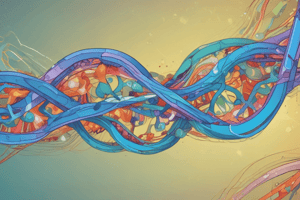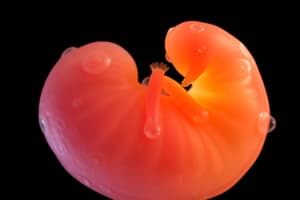Podcast
Questions and Answers
Which type of heart has no neural control to regulate pumping?
Which type of heart has no neural control to regulate pumping?
- Three-chambered heart (correct)
- Heart with a ventricle
- Heart with a sinus venosus
- Heart with an atrium
What is the main difference between the circulatory system of open and closed systems?
What is the main difference between the circulatory system of open and closed systems?
- Extent of the capillary system (correct)
- Red blood cells containing hemoglobin
- Presence of blood sinuses
- Neural control of the heart
How do O2 and CO2 mainly get transported in organisms with no blood specifically involved in their transport?
How do O2 and CO2 mainly get transported in organisms with no blood specifically involved in their transport?
- Through red blood cells
- By neural control of the heart
- Via diffusion (correct)
- By respiratory pigments
What is the function of flame cells in nonvertebrate chordates?
What is the function of flame cells in nonvertebrate chordates?
In ancestral vertebrates, how are body fluids different from those of nonvertebrate chordates?
In ancestral vertebrates, how are body fluids different from those of nonvertebrate chordates?
What is the role of archinephric ducts in ancestral vertebrates?
What is the role of archinephric ducts in ancestral vertebrates?
What is the main difference in development between vertebrates and invertebrates?
What is the main difference in development between vertebrates and invertebrates?
What is the role of Hox genes in development?
What is the role of Hox genes in development?
Which germ layer forms the nervous system, including most of the sense organs?
Which germ layer forms the nervous system, including most of the sense organs?
How many Hox genes do vertebrates typically have?
How many Hox genes do vertebrates typically have?
Which germ layer forms the rest of the digestive tract's lining as well as the glands associated with the gut?
Which germ layer forms the rest of the digestive tract's lining as well as the glands associated with the gut?
What distinguishes vertebrates in terms of Hox genes?
What distinguishes vertebrates in terms of Hox genes?
When did the first duplication event of the Hox complex occur?
When did the first duplication event of the Hox complex occur?
What does the mesoderm germ layer form?
What does the mesoderm germ layer form?
Which gland is formed by the endoderm germ layer?
Which gland is formed by the endoderm germ layer?
What role does Neural Crest tissue play in embryological development?
What role does Neural Crest tissue play in embryological development?
Why is the mesoderm germ layer considered significant in development?
Why is the mesoderm germ layer considered significant in development?
How did the doubling and redoubling of the Hox gene sequence impact vertebrates?
How did the doubling and redoubling of the Hox gene sequence impact vertebrates?
What type of tissue layer lies between the dermis and the fascia overlying the muscles in tetrapods?
What type of tissue layer lies between the dermis and the fascia overlying the muscles in tetrapods?
What is the main function of the subcutaneous fat stored in the hypodermis of tetrapods?
What is the main function of the subcutaneous fat stored in the hypodermis of tetrapods?
Which type of mineral is unique to vertebrates and provides resistance to acid, especially during anaerobic metabolism?
Which type of mineral is unique to vertebrates and provides resistance to acid, especially during anaerobic metabolism?
Why might vertebrates have evolved a skeleton made of hydroxyapatite instead of calcite?
Why might vertebrates have evolved a skeleton made of hydroxyapatite instead of calcite?
What are the hydroxyapatite crystals aligned on in the mineralized tissues of vertebrates?
What are the hydroxyapatite crystals aligned on in the mineralized tissues of vertebrates?
In which region of tetrapods are subcutaneous striated muscles found?
In which region of tetrapods are subcutaneous striated muscles found?
What is another term used to refer to the pharyngeal arches?
What is another term used to refer to the pharyngeal arches?
Which term is used to describe the gill arches in the passage?
Which term is used to describe the gill arches in the passage?
What is the embryonic name for the structures that are referred to as gill arches in adults?
What is the embryonic name for the structures that are referred to as gill arches in adults?
What does the term 'branchial arches' mean?
What does the term 'branchial arches' mean?
What is the relationship between the splanchnocranium and neural-crest tissue?
What is the relationship between the splanchnocranium and neural-crest tissue?
In which group of organisms is a structure functionally equivalent to the vertebrate splanchnocranium present?
In which group of organisms is a structure functionally equivalent to the vertebrate splanchnocranium present?
What is the main role of the kidney in volume regulation in freshwater environments?
What is the main role of the kidney in volume regulation in freshwater environments?
Which ions are primarily regulated by the gills?
Which ions are primarily regulated by the gills?
What is the main function of the notochord in vertebrates?
What is the main function of the notochord in vertebrates?
What is the significance of myomeres in vertebrates?
What is the significance of myomeres in vertebrates?
Which fins are absent in the initial stages of development?
Which fins are absent in the initial stages of development?
What is the presence of dorsal fins indicative of in vertebrates?
What is the presence of dorsal fins indicative of in vertebrates?
What is the significance of neural crest tissue in vertebrate embryonic development?
What is the significance of neural crest tissue in vertebrate embryonic development?
How does neural-crest tissue in vertebrates differ from a similar population of cells found in amphioxus?
How does neural-crest tissue in vertebrates differ from a similar population of cells found in amphioxus?
What are placodes and how do they contribute to vertebrate development?
What are placodes and how do they contribute to vertebrate development?
What morphological feature shared between tunicates and vertebrates may indicate a precursor to the vertebrate neural crest?
What morphological feature shared between tunicates and vertebrates may indicate a precursor to the vertebrate neural crest?
What implications would the presence of eyes and a muscular pharynx in the Cambrian chordate Haikouella have in terms of neural crest evolution?
What implications would the presence of eyes and a muscular pharynx in the Cambrian chordate Haikouella have in terms of neural crest evolution?
How do neural-crest cells contribute to the formation of structures in vertebrates?
How do neural-crest cells contribute to the formation of structures in vertebrates?
What is the exception in the genes coding for the vertebrate brain found in amphioxus?
What is the exception in the genes coding for the vertebrate brain found in amphioxus?
What reinforces the belief that differences in gene expression are as important as differences in gene presence?
What reinforces the belief that differences in gene expression are as important as differences in gene presence?
What are two unique vertebrate features mentioned in the text?
What are two unique vertebrate features mentioned in the text?
What are the main systems contrasted between vertebrates and nonvertebrate chordates in Table 2-1 and Figure 2-4?
What are the main systems contrasted between vertebrates and nonvertebrate chordates in Table 2-1 and Figure 2-4?
What are some structures found in a generalized chordate like amphioxus?
What are some structures found in a generalized chordate like amphioxus?
What is the significance of the tripartite brain in hypothetical primitive vertebrates?
What is the significance of the tripartite brain in hypothetical primitive vertebrates?
What is the function of the subcutaneous striated muscles found in the hypodermis of mammals?
What is the function of the subcutaneous striated muscles found in the hypodermis of mammals?
Why is hydroxyapatite preferred over calcite in vertebrates' mineralized tissues?
Why is hydroxyapatite preferred over calcite in vertebrates' mineralized tissues?
Describe the composition of vertebrate mineralized tissues.
Describe the composition of vertebrate mineralized tissues.
Explain the structure of hydroxyapatite crystals in vertebrate mineralized tissues.
Explain the structure of hydroxyapatite crystals in vertebrate mineralized tissues.
Where is subcutaneous fat stored in tetrapods?
Where is subcutaneous fat stored in tetrapods?
What type of tissue layer contains collagenous and elastic fibers in tetrapods?
What type of tissue layer contains collagenous and elastic fibers in tetrapods?
What is the structure from which teeth form in jawed vertebrates?
What is the structure from which teeth form in jawed vertebrates?
How are teeth of jawed vertebrates structurally composed?
How are teeth of jawed vertebrates structurally composed?
What controversial debate exists regarding the origin of dental tissues?
What controversial debate exists regarding the origin of dental tissues?
What is the embryonic origin of teeth in some fishes, contrary to the general belief?
What is the embryonic origin of teeth in some fishes, contrary to the general belief?
Describe the basic structure of teeth in jawed vertebrates.
Describe the basic structure of teeth in jawed vertebrates.
What is the structure from which shark scales (dermal denticles) form?
What is the structure from which shark scales (dermal denticles) form?
Flashcards are hidden until you start studying
Study Notes
Vertebrate Characteristics
- Vertebrates have a closed circulatory system with a heart that pumps blood throughout the body.
- Heart has three chambers: sinus venosus, atrium, and ventricle.
- No neural control of the heart in early vertebrates, but present in all except hagfishes.
Circulatory System
- Closed circulatory system without blood sinuses, except in hagfishes and lampreys.
- Extensive capillary system present in vertebrates.
- Blood involved in the transport of respiratory gases (O2 and CO2) with the help of hemoglobin.
Excretion and Osmoregulation
- Specialized glomerular kidneys present in vertebrates for ultrafiltration of blood.
- Kidneys lead to the outside via the archinephric ducts to the cloaca.
- Body fluids are more dilute than seawater, except in hagfishes.
Development and Germ Layers
- Vertebrates have three germ layers: ectoderm, endoderm, and mesoderm.
- Ectoderm forms the outermost layer, including skin and nervous system.
- Endoderm forms the digestive tract and associated glands.
- Mesoderm forms muscles, skeleton, and circulatory and urogenital systems.
Skeletal System
- Hydroxyapatite, a complex compound of calcium and phosphorus, is unique to vertebrates.
- Skeleton made of hydroxyapatite is resistant to acidification of the blood.
- Hydroxyapatite crystals are aligned on collagenous fibers in layers with alternating directions.
Hox Genes
- Hox genes regulate the expression of a hierarchical network of genes controlling development from front to back along the body.
- Vertebrates have more Hox genes than other animals, with duplications of the entire Hox complex.
Neural Crest
- Neural crest is a new tissue in embryological development that forms novel structures in vertebrates, especially in the head region.
- Neural-crest cells originate at the lateral boundary of the neural plate and migrate throughout the body to form various structures.
Placodes
- Placodes are epidermal thickenings that give rise to complex sensory organs, including the nose, eyes, and inner ear.
- Placodes are similar to neural crest but have a different origin.
Studying That Suits You
Use AI to generate personalized quizzes and flashcards to suit your learning preferences.




